DockATot Review: Not Recommended
2025 update!
First published: June 9, 2017. Last Updated: . DockATot Review: Not Recommended.
October 2019 update: Consumer Reports says two infant deaths have been linked to DockATot. The company refuses comment.
April 2021 update: DockATot publicly disavows using the product in a bed in this update posted to their web site: "Until there is further development on a mandatory standard for all products offered for bedsharing, we will no longer promote our docks for use in bedsharing.” However, Consumer Reports finds the company is still marketing the product for sleeping however: "Though DockATot recently stopped explicitly promoting its product for bed-sharing, as of this April its marketing still showed images of babies sleeping in the product and pictures suggestive of bed-sharing. "
Quick summary: We do not recommend the DockATot (and similar co-sleepers/infant loungers like the Snuggle Me), based on safety concerns raised by government safety regulators and independent infant sleep researchers about infant sleep positioners.
Don't have time to read this entire report? Here are 5 quick take-aways on the DockATot and why we don't recommend it:
- The DockATot is designed and marketed as an in-bed co-sleeper—a device designed as a space for baby to sleep while in an adult bed. According to infant sleep safety experts we interviewed, there are numerous and well-documented dangers to having an infant sleep in an adult bed—pillows, comforters, pets and other items can shift and pose a suffocation hazard to baby. Canada has blocked the sale of the DockATot for this reason.
- DockATot's social media regularly shows the product used in ways we think are dangerous—in a hammock, in an adult bed surround by pets, siblings or soft bedding (pillows, comforters, etc). This is irresponsible, in our opinion . . . and is ironically contradicted by DockATot's own safety warnings about the product.
- DockATot's safety instructions are confusing and impossible to follow, in our opinion. Adults must be "semi-alert" but not necessarily awake when using the DockATot for an infant. At the same time, DockATot warns it is "not to be used for unsupervised sleep." It is unclear how any adult could be sound asleep AND simultaneously supervising an infant sleeping next to them in a DockATot.
- DockATot claims its product is tested for "air permeability" (as recently as 2017, the company claimed DockATot was "100% breathable"). But this test is based on a British safety standard that is over 40 years old and questionable in relevance to current research on infant sleep safety.
- Infant sleep positioners have been implicated in product safety recalls that sadly involved infant deaths. While these positioners were somewhat different in design from the DockATot, misuse of sleep positioners in cribs and other sleep environments is a serious risk, in our opinion.
Bottom line: Don't use a DockATot for co-sleeping. If you already own a DockATot, we would not use it for sleeping; other uses (such as diaper changing or tummy time) would be ok.
In this report:
- Why trust us?
- What is the DockATot?
- A brief history of the DockATot
- DockATot’s founder: “Unapologetic co-sleeper”
- Why is co-seelping with a DockATot dangerous?
- Hands-on inspection of a DockATot
- DockATot’s claims about safety, shifting over time
- Semi-alert? But asleep?
- Dangerous precedent: The Nap Nanny story
- Dumpster fire! DockATot’s social media—dangerous uses, fake airline endorsements.
- The take-home message: do not use the DockATot as an in-bed co-sleeper
Why trust us?
We have been reviewing and rating baby gear since 1994. Our best-selling book on baby gear, Baby Bargains, has over 2 million readers and is currently in its 12th edition. The New York Times said our book is the “bible for new parents to be.” Read more about us here.
What is a DockATot?
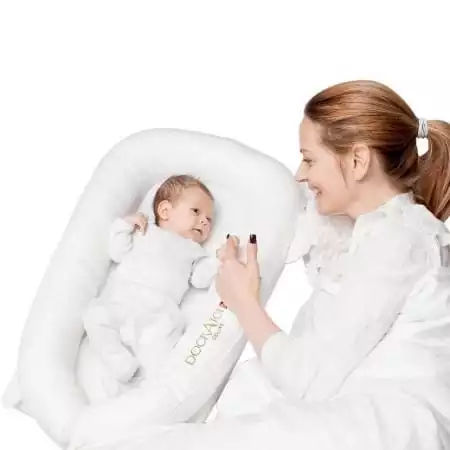
While the DockATot is pitched as multi-functional baby lounger, it is most often featured as a co-sleeper next to an adult in an adult bed.
The DockATot is pitched as “a multi-functional lounging, playing, chilling, resting and snuggling dock for baby and tots 0-36 months,” according to the company. Made in Europe, the DockATot comes in two sizes: Deluxe (for 0-9 months) and Grand (9-36 months). It sells for $160-$230 in stores and online.
While the company officially plays down the use of the DockATot as an in-bed co-sleeper (at least on its US web site), DockATot’s social media regularly features the product being used in an adult bed. (Below, a picture from DockATot's Instagram account, January 3, 2017; emphasis ours).
A brief history of the DockATot
The DockATot first debuted as the SleepyHead in Sweden in 2006. It was launched in the US as the DockATot in July 2015—it is the same product, just sold under different names. In the UK, Europe and other parts of the world, the product is sold as the Sleepyhead. In North America, it is known as DockATot.
As sales and controversy grew in 2016 and 2017, we posted our first review of the DockATot in June 2017; this review is an updated and revised version of that post.
DockATot’s rapid rise has been fueled in part by social media; its Instagram account has 462,000* followers, as of this writing. (*As with any Instagram account with six-figure followers, it is impossible to verify whether all those followers are real.)
DockATot’s inventor: an “unapologetic co-sleeper”
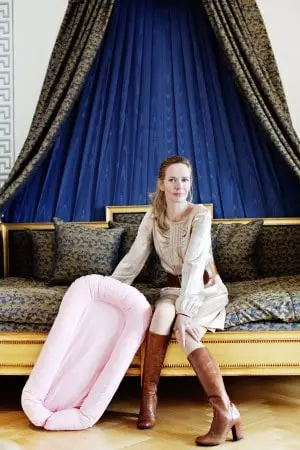
DockATot founder Lisa Furuland poses with the product for an interview with BossLady.com
Invented by Swedish entrepreneur and co-sleeping advocate Lisa Furuland, the DockATot is the main offering from Furuland’s company, Enfant Terrible. The company is based in Norrtälje, Sweden. The DockATot is manufactured in Estonia with fabrics from Portugal.
With a background in art history and design, Furuland cited the inspiration for the product as a desire to find a “multi-functional” baby bed in one piece:
“I searched unsuccessfully for an alternative to the blanket, the cot (crib) and the baby lounger, something more snug and at the same time more versatile.” Source: Sleepyhead English language web site
In an interview with BABY BARGAINS at a 2016 trade show, Furuland describes herself as an “unapologetic” co-sleeper. She said that many parents in the US and elsewhere are co-sleeping with their baby in an adult bed—and her goal was to make it safer.
Co-sleeping risks lead Canada to ban the DockATot
Yes, co-sleeping is a controversial topic in parenting circles.
The American Academy of Pediatrics doesn’t recommend the practice, which is more common in non-Western cultures. (For the record, the AAP encourages parents to share a ROOM with their newborn to encourage breastfeeding, but not share a BED).
Despite this, co-sleeping is “surprisingly common in early infancy,” said a 2016 New York Times article about a recent study on co-sleeping in the US:
Nearly 75 percent of the parents co-slept with infants early on, and about half were still co-sleeping three months after the birth. But once the babies reached 6 months of age, only one in four babies continued to share a bed or a room with their parents.
The debate about whether co-sleeping is good or bad is beyond the scope of this review—but folks are doing it . . . especially in those early months (birth to six months) when the risk for Sudden Infant Death Syndrome is at its peak.
With that safety issue front and center, Canada blocked the sale of DockATot and other “baby nests” in 2017 because they deemed them a suffocation risk.
So are baby nest or pod companies like DockATot and Snuggle Me just responding to a market need? Perhaps. After all babies like snug places when they sleep (hence the popularity of swaddling). Or are these companies encouraging more parents to co-sleep by touting these products as a safer way to co-sleep?
Leaving aside that debate, what does the scientific research say about the safety of devices like this?
Known danger: crib bumpers
Crib bumpers have been associated with Sudden Infant Death Syndrome. So does the DockATot function like a crib bumper? DockATot’s UK-facing web site safety FAQ says it is a crib bumper:
Please note that soft objects such as pillows, quilts and stuffed toys should not be kept in the Sleepyhead®. Also, make sure not to use plush non-breathable crib bumpers. With Sleepyhead®, crib bumpers are in fact redundant, as the protective sides of the Sleepyhead® prevent the babies extremities from getting caught between the slats of the crib. (emphasis added)
And when we inspected the DockATot first hand, we noticed its safety tag refers to the sides as a bumper. In a detailed 2017 blog post on cleaning on its site (now deleted), DockATot itself referred to the sides of the product as a “bumper tube.”
As a result, Maryland and Ohio (as well as cities like Chicago) have banned the sale of crib bumpers. Yet as of this writing, the DockATot is sold in these cities and states.
Known danger: sleep positioners inside a crib
So here's a riddle: is it safe to use a DockATot inside a crib or bassinet? The answer: it depends WHERE you are.
In Europe, DockATot (as Sleepyhead) says yes, go ahead and use it in a crib. They even put a picture of the DockATot in a crib on their European web page and called it a "crib reducer."
In China, DockATot showcased the product in a crib at a trade show booth in July 2018:
Meanwhile, in the United States, there's a different story. DockATot's warning label says "NEVER use in a crib, bassinet or other contained area." Here's a graphic from the company's FAQ on the US-facing site:
Why? DockATot blames this prohibition on "guidelines put out by the Consumer Product Safety Commission."
We put safety first. There have been incidents where babies have suffocated after becoming entrapped between a soft product and the side of a crib, bassinet, wall, or other surface, and also incidents where babies have suffocated on soft bedding like blankets or soft toys. This is why we warn against using a DockATot in a crib, bassinet or other contained area, and warn that blankets and pillows should not be placed in the DockATot.
So . . . we care about the safety of babies in the US so never use it in a crib. But babies in the UK, Europe or China? Whatever!
A UK mom blasted the company on this obvious contradiction, which we blogged about here.
Next up: let's take a look at the DockATot with a hands-on inspection.
Hands-on inspection of a DockATot with a top safety expert
We purchased a DockATot from Target.com and shipped it to Dr. Rachel Y. Moon, a renowned infant sleep safety expert who wrote the most recent American Academy of Pediatrics infant sleep guidelines.
Dr. Moon evaluated the DockATot at our request and pointed out the base surface of the DockATot is quite thin. So while the DockATot’s “breathability” claim may be true, how safe it is could be entirely dependant on the underlying sleep surface—that is the mattress on an adult bed.
And that’s where there could be trouble—if you sleep on a futon mattress or a mattress with a pillow topper, the underlying surface for the DockATot could be a safety hazard.
“I am quite concerned about the padding all around the edges. If the child was on a firm surface, it may be unlikely for the baby who turned to the side to have his/her face pressed against the side. However, if the child was on a soft surface, there is potential for the baby’s body to sag below the level of the side – and make it more of a suffocation hazard,” said Dr. Moon, who is also a professor of pediatrics at the University of Virginia School of Medicine.
To test this concept, we added a 20 lb. weight to our sample DockATot to simulate a 9 month infant—the DockATot was sitting on a hardwood floor. The DockATot has a sling-like bottom—when empty, it measures about 2.5" deep:
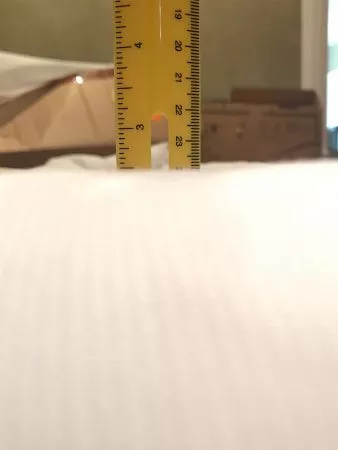
When empty, the DockATot measures about 2.5 inches form the base to the to of the bumper.
When we added the weight to approximate a nine-month old baby, the distance was now 3.5", as the weight depressed the surface.
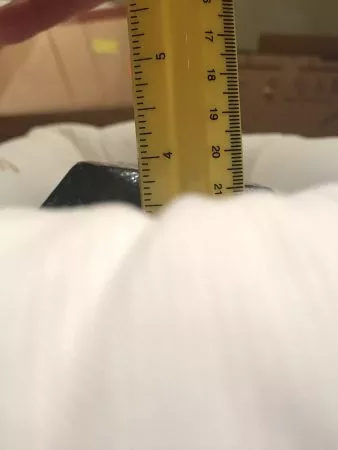
The DockATot's surface sinks about one inch when a 20 lb weight is added.
So even on a hard surface, a baby would sink about an inch deeper into the DockATot. Yes, the company warns to always use the DockATot on a "firm, flat surface" on its safety label. But most adult beds would never meet that definition, in our opinion.
We should caveat that this hazard is theoretical. We have not found any cases of an infant suffocating in a DockATot (including a search of SaferProducts.gov), although other in-bed co-sleepers have been implicated in suffocation deaths, such as this 2016 story from Australia.
Here are some more pictures of our unboxing of the DockATot we purchased for testing and evaluation. Click on the photo below to enable the slideshow.
DockATot’s claims about use and safety: shifting over time
Since its debut in 2015, DockATot has made and retracted various claims about its use and safety. Here's a run-down.
DockATot: Co-sleeper for adult beds? Infant sleep positioner?
On the very first web page DockATot posted in 2015 for US parents, there is a picture of the DockATot in an adult bed, touting its use as a co-sleeper:
DockATot dropped that claim in 2016 and moved its marketing on that point to its social media (more on this shortly).
Also in 2017, we found online descriptions of the DockATot being sold as a "sleep positioner."
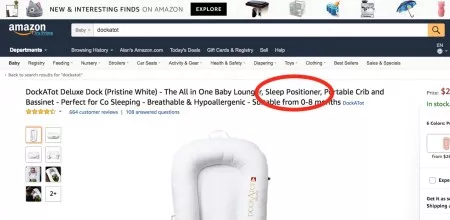
This screen grab from May 2017 shows the DockATot marketed as a "sleep positioner."
Sleep positioners are dangerous, says the Consumer Product Safety Commision. The CPSC teamed with the Federal Drug Administraion to issue a joint warning on sleep positioners in 2010.
“Over the past 13 years, the CPSC and the FDA have received 12 reports of infants between the ages of one month and four months who died when they suffocated in sleep positioners or became trapped and suffocated between a sleep positioner and the side of a crib or bassinet.”
The CPSC described sleep positioners as “flat mats with side bolsters or inclined (wedge) mats with side bolsters.”
We asked the company for a comment on this. DockATot spokesperson Elina Furman wrote back: "I am not sure who wrote up the product description on Amazon but we strictly market (it) as a baby lounger and cosleeper which we are approved for."
After our 2017 review appeared, all ecommerce descriptions of the DockATot as a sleep positioner disappeared.
100% breathable?
In 2017, DockATot claimed the product is “100% Breathable, Complies with BS4578” in a graphic on its web page:

The DockATot's safety and breathable claims.
What is BS4578? BS4578 is a British safety standard on pillows written in 1970—yes, 1970. Specifically, the standard is a “specification for methods of test for hardness of, and for air flow through, infants' pillows.”
Here’s how DockATot described its safety testing in a post to their web page and a Facebook post in 2016:
"Did you know the DockATot has been safety tested beyond any other baby sleeping product on the market?
Both mattress pad and bumper have great air-permeability and comply with BS4578. BS4578 is the result of an objective to produce a British Standard specification for a pillow which can confidently be used in cots [cribs], perambulators [strollers] etc.
The BSI Committee for Nursery Bedding has tried to consult anyone who may be able to contribute to the solution of the problem of a British Standard safe pillow, and the inquiries have included consultation with physiologists about the breathing of young children (quantity and rate flow of air, psychological and other effects if air flow becomes restricted, etc.). The test is designed to replicate a baby placing its mouth on/against an item, and measures how easily it can breathe through the item. It measures the pressure (in mmH2O) required to allow 12 liters of air per minute through the item (which is how much a baby typically breaths).
The sides of DockATot DELUXE as well as the GRAND, which are in close proximity to the baby’s face, allow for relative easy breathing and comply with the requirements of BS4578. The same goes for the base (the mattress incl. its protective cover). Even if a baby's mouth and nose are covered by the bumper (which anyways is impossible due to the firmness of the filling), or facing straight down (which a baby doesn't do by itself) - an infant can still breathe with relative ease (as per the test compliance)."
DockATot's claim that it is "safety tested beyond any other baby sleeping product on the market" is impossible to prove or disprove—this grandiose statement aims to comfort parents, but it is meaningless.
Our opinion: research into Sudden Infant Death Syndrome has progressed quite a bit since 1970. Numerous more recent studies show a correlation between SIDS and soft bedding like pillows, crib bumpers and the like. Citing a 48-year old British pillow safety standard to declare your 2018 sleep positioner safe is questionable, in our opinion.
Most importantly, the U.S. does not have a “breathability” safety standard for infant sleep devices—infant sleep safety advocates do not believe they are safe in any form. Complying with a British safety standard does not mean the product is safe for US parents to use. The ONLY government certified safe sleep environments in the US are cribs, mini cribs and bassinets that meet federal standards.
After we publicly questioned this claim in our June 2017 review, DockATot dropped this claim. Now it says the product is “Tested”. On a revised safety page, there is still a reference to the British safety standard we discuss above.
Semi-alert? But asleep?
One of the biggest criticisms of the DockATot is the brand’s safety advice that we think is contradictory and impossible for parents to follow.
Example: DockATot says it should be used in a sleep environment that is supervised by an adult. Here’s the specific quote that appeared on their website in 2017 (now deleted—but still visible on their Australian web site):
“The DockATot Deluxe should not be used for unsupervised sleep (emphasis ours). A supervised environment is one in which a semi-alert, non-inebriated adult is co-sleeping next to baby. Adult does not need to be awake next to baby.”
Let’s unpack that for a moment. How do you supervise baby while you're sleeping, exactly? How can you be semi-alert yet asleep?
The whole point of putting baby in a crib or bassinet that meets current safety standards is baby can sleep UNSUPERVISED. That is, an adult (alert or not) doesn’t need to be standing nearby at all times to make sure baby is safe.
If a baby wakes up in her crib and rolls over, then odds are, everything would be fine (assuming there is no soft bedding, bumpers, stuffed animals, etc. in the crib).
Yet if a baby in a DockATot or other co-sleeper wakes up and rolls over, what happens if they wedge themselves next to the “bolsters” that even DockATot says function like crib bumpers? How can an adult be deep in sleep and also supervise a baby in a DockATot?
Remember that babies can roll over as soon as two months (source: Denver Developmental Checklist). And 90% of SIDS deaths occur in the first six months of life.
That’s what prompted the 2010 CPSC and FDA warning about sleep positioners—putting bolsters, crib bumpers and other devices next to a sleeping baby is dangerous, say government safety regulators.
Dangerous Precedent? The Story of the Nap Nanny
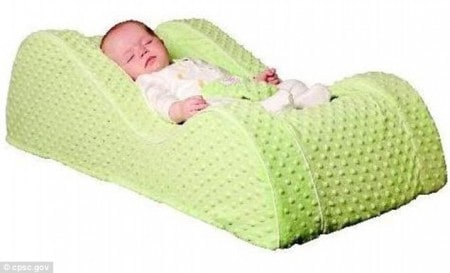
The Nap Nanny was recalled after several infant deaths and multiple injuries.
The danger of using a product like the DockATot in a crib or bassinet reminds us of another infant lounger from earlier in this decade: the Nap Nanny. (Tip of the hat to Kids in Danger for pointing out the parallels).
Five babies died from 2009 to 2013 after using the “infant lounger,” prompting a recall from the CPSC. The company that made it went out of business.
The deaths happened when babies were put in a Nap Nanny, which was then put in a crib—despite warnings from the manufacturer to never use the product in a crib. Babies fell out of the Nap Nanny and suffocated between the product and the crib mattress.
In addition to the five deaths, there were 92 reports of injuries to infants who fell over the sides.
The Nap Nanny is clearly designed differently than the DockATot and its similar competitors. But the concept was basically the same: a comfortable space for baby to lounge and nap. (Read more on the Nap Nanny history here.)
We've long advocated for infant sleep safety—including blogging about concerns with "newborn nappers" with a popular play yard and with the Fisher Price Rock N Play Sleeper.
The Nap Nanny lessons: even when you warn parents about putting sleep positioners in a crib, the product can still end up in a dangerous place. For example, we've seen online discussions where parents talk about putting the DockATot in a crib (example: this one from BabyCenter in Canada). And as mentioned above, even reviewers on mainstream sites like TheBump are ignoring the warning and using a DockATot in a crib.
DockATot’s Addictive Secret
Here’s another not-so-obvious reason why using a product like DockATot is dangerous: newborns can get addicted to them. Parents too!
To understand why, let’s look at how infants sleep. Here’s the simple explanation: From newborn to about four months of age, babies are incapable of soothing themselves—whether to go to sleep, to get back to sleep when awakened, etc.
These young newborns love womb-like experiences—swaddle blankets, baby bouncers that vibrate, snug baby carriers, etc. Hence, the popularity of products like the Fisher Price Rock N Play sleeper.
But something happens around four months of age. Babies become AWARE of their sleep environment. Hence when you put a baby about that age down to sleep in a DockATot or Rock N Play sleeper, they remember it . . . and can grow very attached to it.
Now let’s imagine that a parent is transitioning a four or five month old baby from co-sleeping in an adult bed to a solitary sleep space like a crib. If he is used to being cocooned in a DockATot, baby may protest when put down in a crib without it—especially a baby who is older than four or five months age.
And when we say “protest,” we’re being charitable. We can understand why parents desperate for a decent night sleep would let a four month old use the DockATot . . . but now inside a crib, instead of a parent’s bed.
And that’s where the Nap Nanny and other “infant loungers” got into trouble; they can become too successful at soothing a baby. Despite explicit warnings about not using the product in a crib, parents did it anyway. And that can lead to a very dangerous situation.
Think the risk of a parent moving a baby to a crib with the DockATot is only a theory? We found several pictures of babies in a DockATot in a crib (#dockatot) on Instagram in the past few months. (Note: these were NOT reposted by DockATot). Our intention here is NOT to blame these parents, but instead to point out an aggressively marketed infant sleep device like the DockATot can lead to dangerous misuse—and that misuse is easily foreseeable.
Dumpster fire! DockATot’s social media—dangerous uses, fake airline endorsements.
Updated December 2018: After we posted the examples below, we noticed DockATot has cleaned up its social media (to its credit). Gone are most image types that we discuss below (but there are still photos of DockATots in adult beds—which is unsafe in our opinion).
Before we launch into the dumpster fire that is DockATot’s social media posts, let’s take a second to point that we’ve been researching and writing about baby gear since 1994. Yes, 1994.
That means we’ve researched and written about hundreds of baby gear companies. Most are honest and reputable. Yes, we’ve had a few that have had some shameful safety recalls (Maclaren strollers, white paging telephone). And a few that were involved in financial shenanigans.
But we can say with confidence that no company has been as reckless with marketing as DockATot, in our opinion. And after doing this job for so long, as the saying goes, we know a thing or two because we’ve seen a thing or two.
When we say DockATot's social media is reckless, we mean the company is showing the product being used in an unsafe manner. Why are these uses unsafe? Because DockATot says they are, in their own safety instructions and online safety FAQ’s. No kidding.
Let’s roll the tape.
FYI: These are actual captures from DockATot’s official Instagram account. We have intentionally blurred the faces of children under the age of 18 and their parents' social media account addresses.
That's because we are not attempting to shame or criticize the parenting choices made here. Folks are free to use a baby product any way they see fit. The issue we are highlighting is a company (DockATot) taking pictures of the product being used in a way the company itself says is dangerous—and sharing them on social media with hundreds of thousands of parents. That is deserving of shame.
Flat, firm, stable surface?
DockATot’s safety label says only to use it on a flat, firm, stable surface.
So why in what world would a company that has that safety warning show its product used in a hammock? Yes, DockATot actually has posted several pictures to its Facebook and Instagram of babies in a DockATot in a hammock. Here's one:
Think that is just a mistake of a young social media intern who went off the reservation one day?
Nope, no one less than DockATot’s founder and CEO Lisa Furuland told Vogue UK in 2017 that “another favorite was seeing the pod in a hammock in Belize”. That would be this picture (now removed from DockATot’s Instagram but widely re-posted online.)
So one of the company owner’s favorite images of her product is used in a way the company says it shouldn’t? Hello?
And we’re just getting started. . .
Do not allow pets in the bed (with a DockATot)
For the past few years, DockATot posted an FAQ on co-sleeping safety. Here's what it looked like:
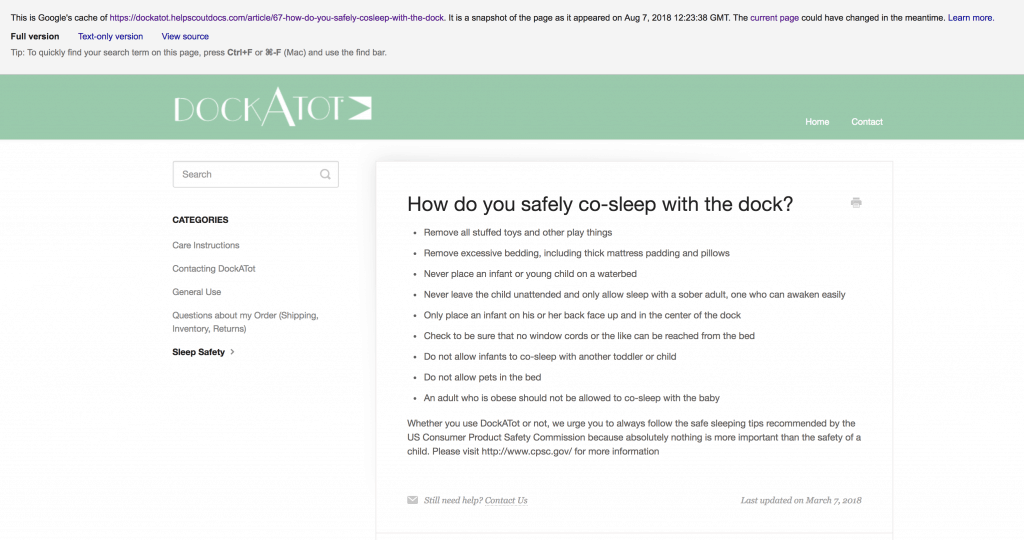
So here are some of DockATot's own safety precautions:
• Do not allow pets in the bed
And then on DockATot's Instagram account . . .
No stuffed toys and other playthings
DockATot's web site says . . .
- Remove all stuffed toys and other play things
Cue the DockATot Instagram . . .
NEVER use on a surface from which baby can fall
Yes, that's what the safety label says:
Do you mean an adult bed like this?
Or perhaps a couch?
Do not allow infants to co-sleep with another toddler or child
Yes, the official DockATot safety FAQ said that in 2018. Can you guess what DockATot's Instagram might show?
Give yourself bonus points if you find the other hazard in this picture—yep, that looks like a comforter pulled halfway up the sleeping baby.
#23 At the pool!
On DockATot's web site, it lists 50 Ways to Use A DockATot. Believe it or not, #23 is "At the pool."
Note: we blurred the face of the child and obscured the parent's Instagram account name. DockATot posted this picture without those redactions.
What could possibly go wrong with having a baby sleep near a pool? Oh, yeah, this. (Update Dec 2018: DockATot has since removed this picture from their web site).
DockATot has repeatedly posted pictures of infants sleeping next to a pool. Or in this case, on an elevated surface . . . next to a pool . . . on a cliff.
Unreal, indeed. As a devil's advocate, you could say this is just Instagram travel porn—pretend shots of the DockATot in exotic locations intended to rack up Instagram hearts.
Yes, we see that point. But again, it is the company's choice to repeatedly repost these to its Instagram account with nearly a half million followers. If it is dangerous to have an infant or toddler asleep in a DockATot next to a pool/lake/ocean, then why show it over and over?
Double Jeopardy!
Now that you get the gist of the DockATot social media, let's play Double Jeopardy. Not content to feature one dangerous use of the DockATot at a time, the company often goes for multiple flags in the same post. Can you pick out all the things DockATot says never to do with a DockATot in this post?
Give yourself bonus points if you noticed the DockATot is on a 1) raised surface (a bed), 2) with a blanket (soft bedding) covering the child plus 3) pets in the bed. We're pretty sure that this DockATot is propped up on a pillow, which is certainly not a 4) flat, firm, stable surface. And is there a parent here that is 5) semi-alert and supervising the child?
Let us repeat: we are not shaming the parents who posted this. We are criticizing DockATot for re-posting this as an example of how to use their product, despite the company's warnings not to do any of this.
The Coup de Grâce: DockATot says it is Southwest Airlines approved!
If all this social media shenanigans weren't enough. DockATot went for the gold with this picture in 2018:
Let's unpack this one for a minute. Not only is DockATot showing the product used on a plane (which is questionable to say the least), but the kicker is the "@southwestair approved" comment line.
So, we asked Southwest Airlines a simple question: is the DockATot approved by the airline for use on planes? The answer was no. (We covered the entire controversy in this blog post).
For the record, a wide consensus of safety experts say the safest place for a baby or toddler on a plane is buckled into a FAA-approved car seat. And sadly, DockATot has repeatedly posted pictures of its product used on a plane.
After we called this out in a spring 2018 post, DockATot removed the post from their Instagram . . . AFTER garnering 11,730 likes and who knows how many views and reposts on Instagram.
So just to review: DockATot not only posted a picture of their product used in a questionable way . . . it mislead customers to think another company was endorsing that use.
Wow. Just wow.
And the P.S. to this story? DockATot then reposted this picture to their website for an article titled 50 Ways To Use Your DockATot. Here it is at number #16.
The Take-Away Message: We Do Not Recommend the DockATot
We do not recommend the DockATot (and similar co-sleepers like the Snuggle Me), based on safety concerns raised by government safety regulators and independent infant sleep researchers.
If you already own a DockATot we would not use it for sleep. Other uses (tummy time, diaper changes, etc) would be fine as long one follows the company's actual safety instructions.
What do you think? Weigh in below in the comments section.
Last Updated: .
DockATot Review: Not Recommended

BabyBargains.com is a participant in the Amazon Services LLC Associates Program, an affiliate advertising program designed to provide a means for sites to earn advertising fees by advertising and linking to Amazon.com and its related sites. As an Amazon Associate, I earn from qualifying purchases.

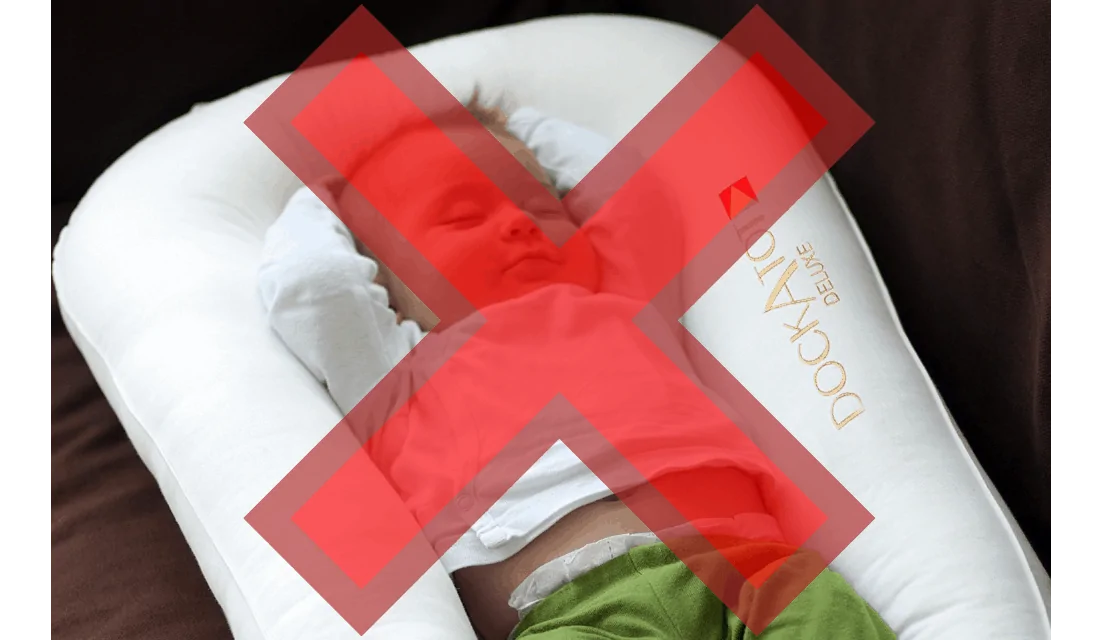
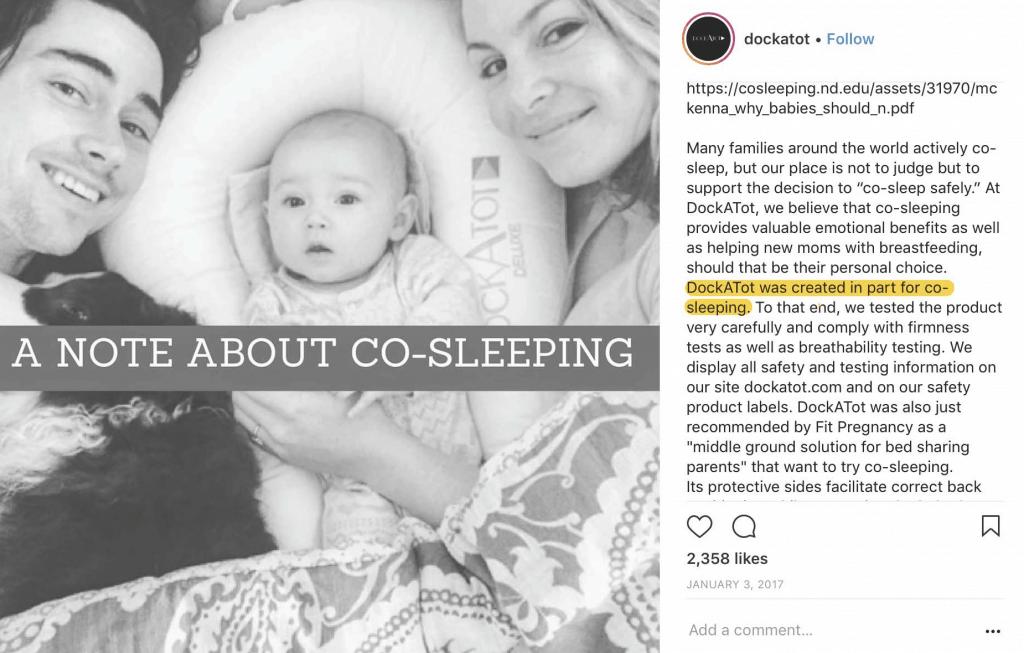

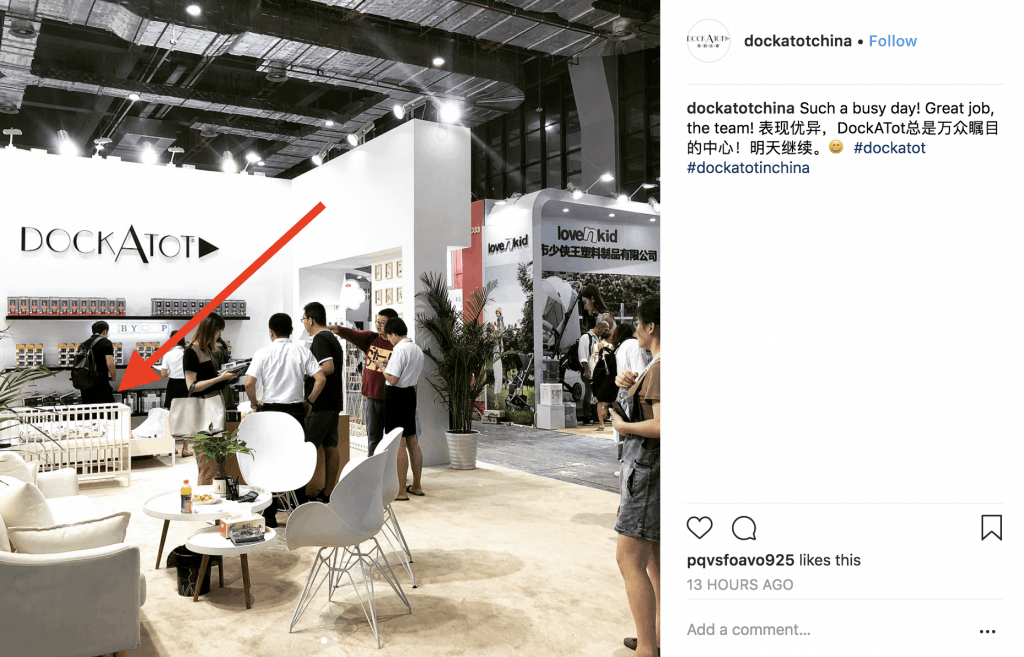
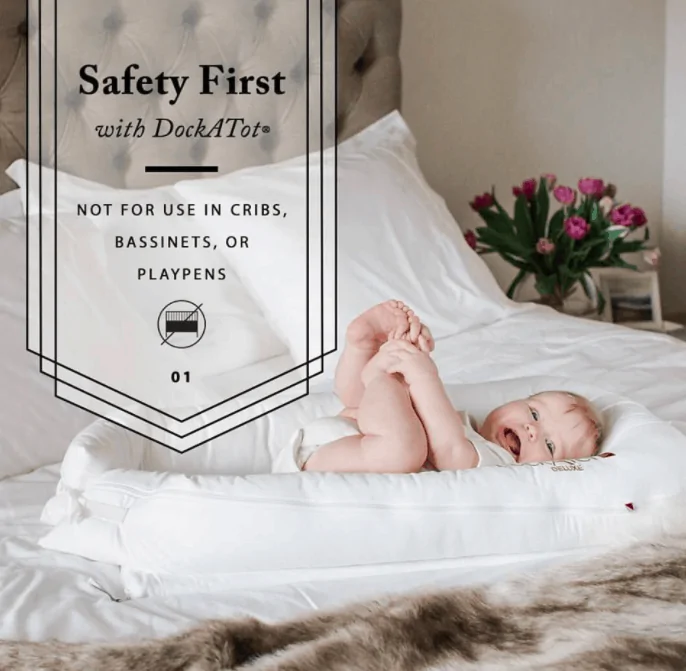
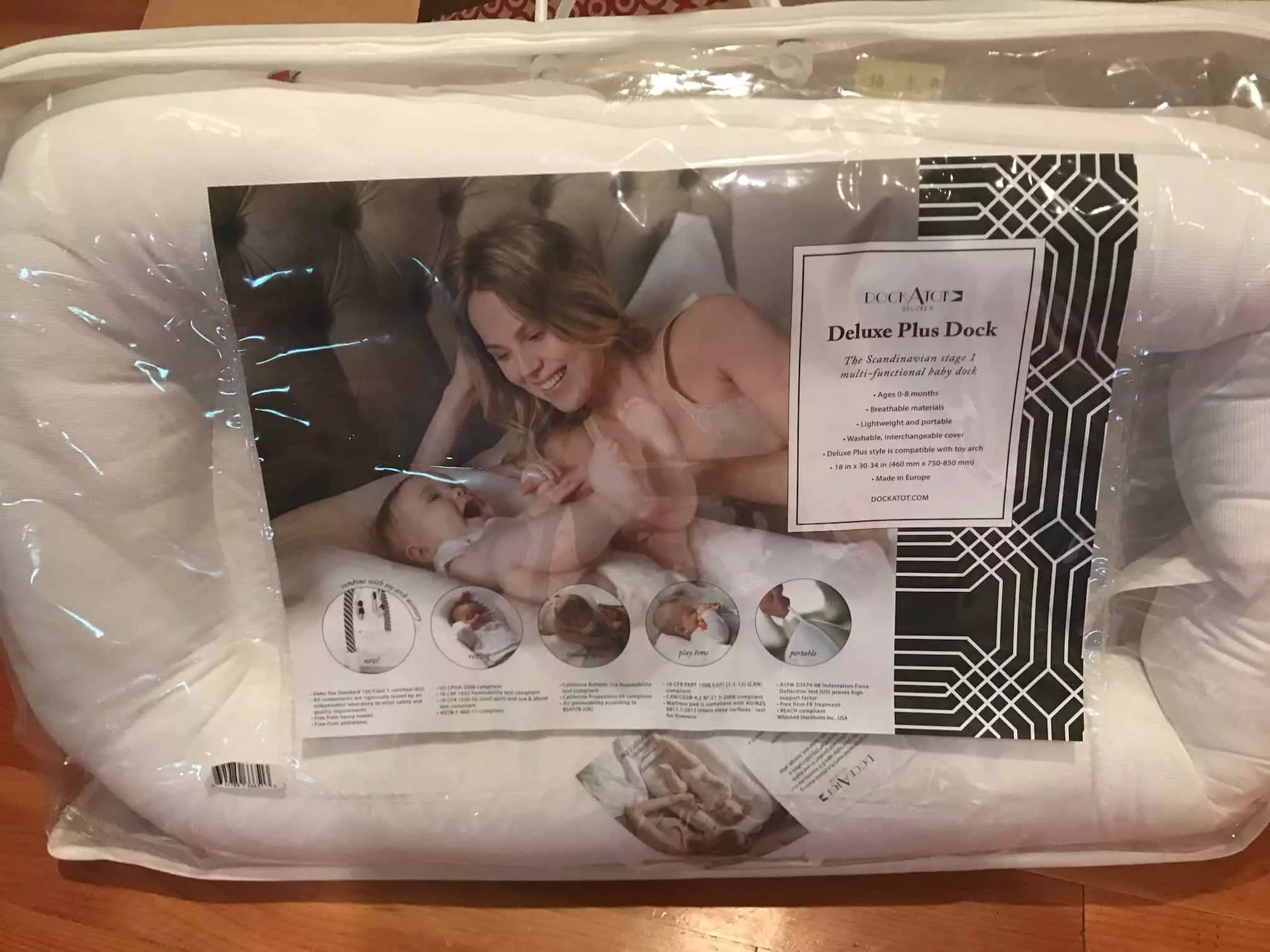
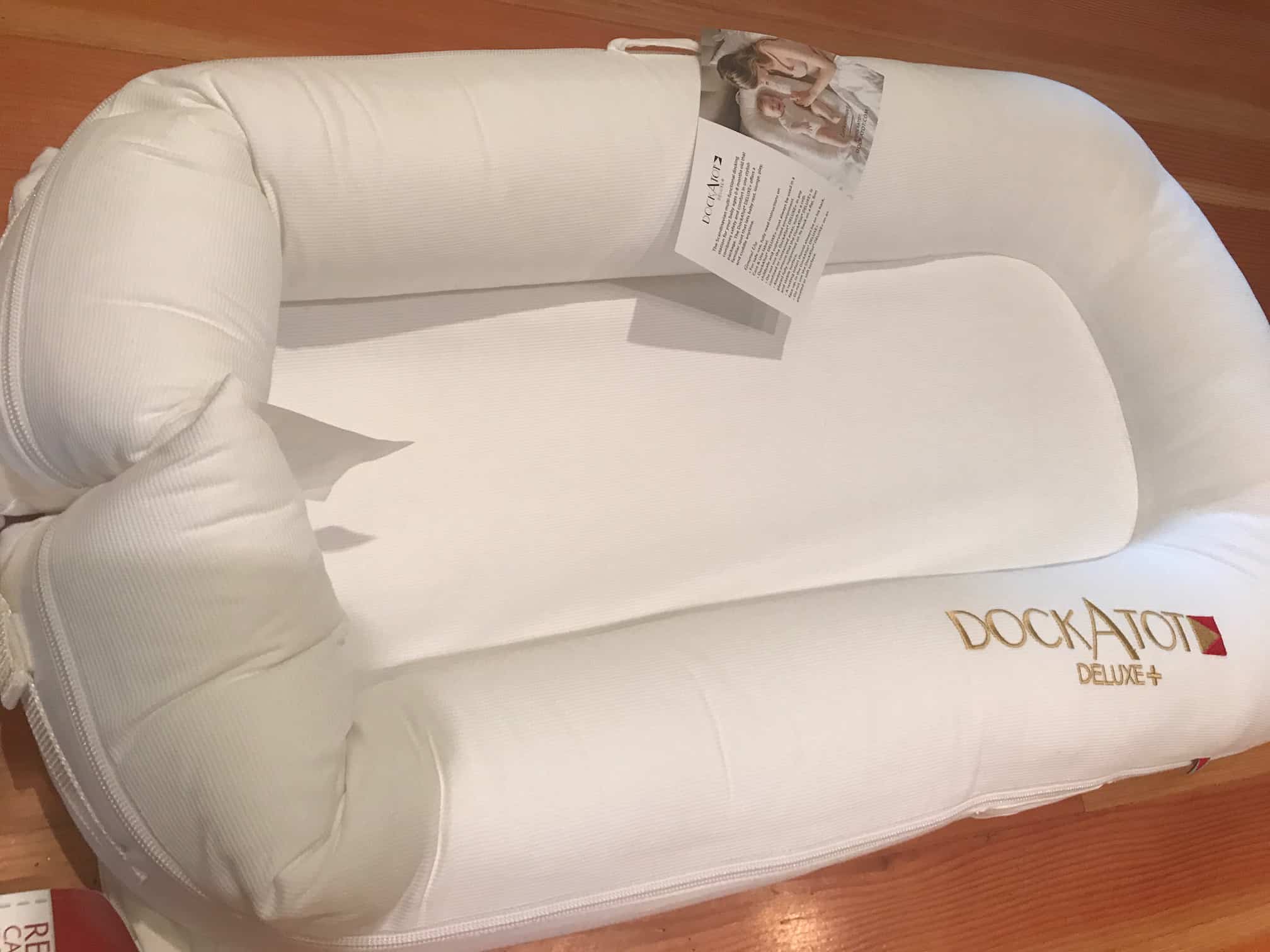


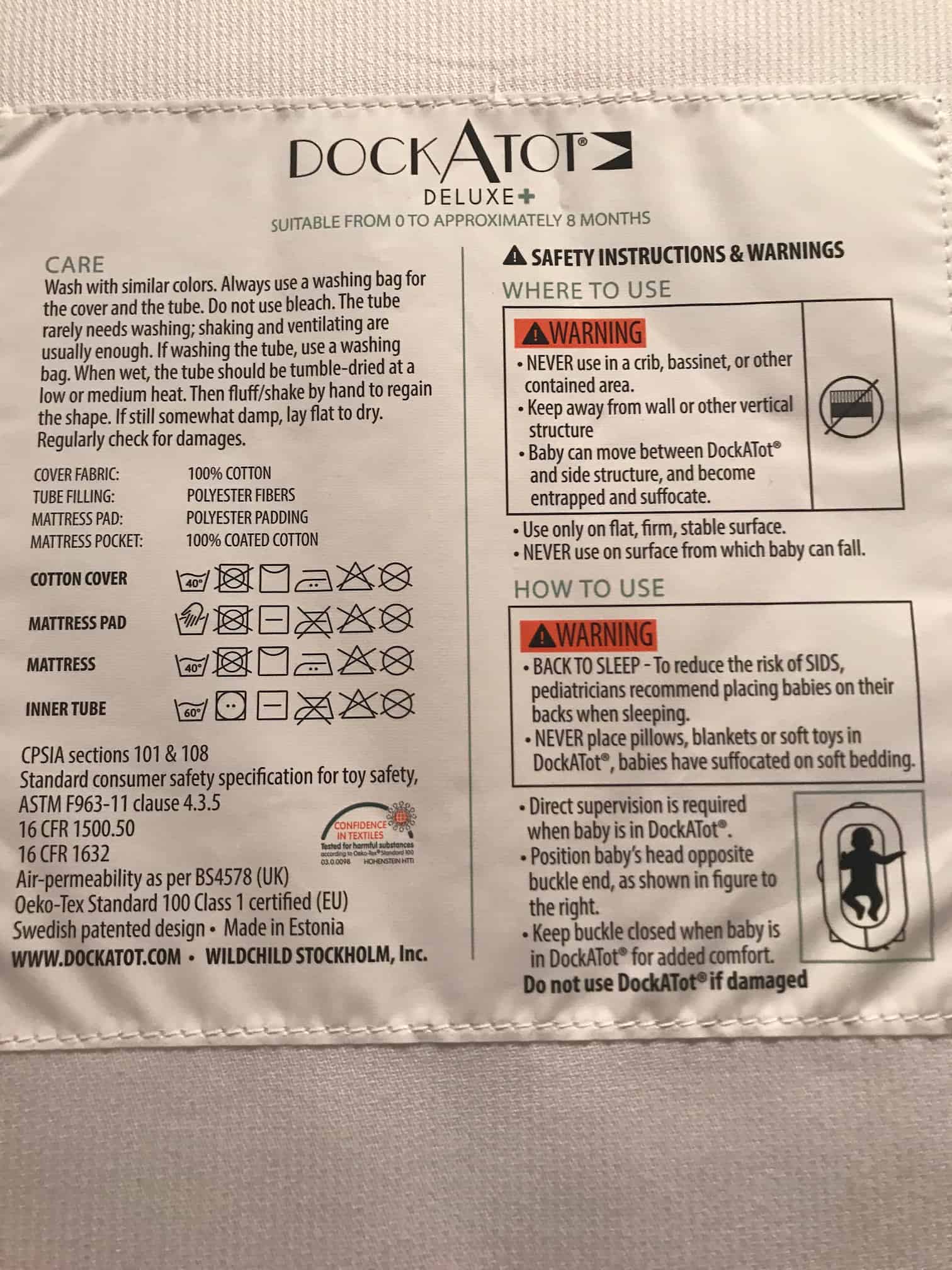
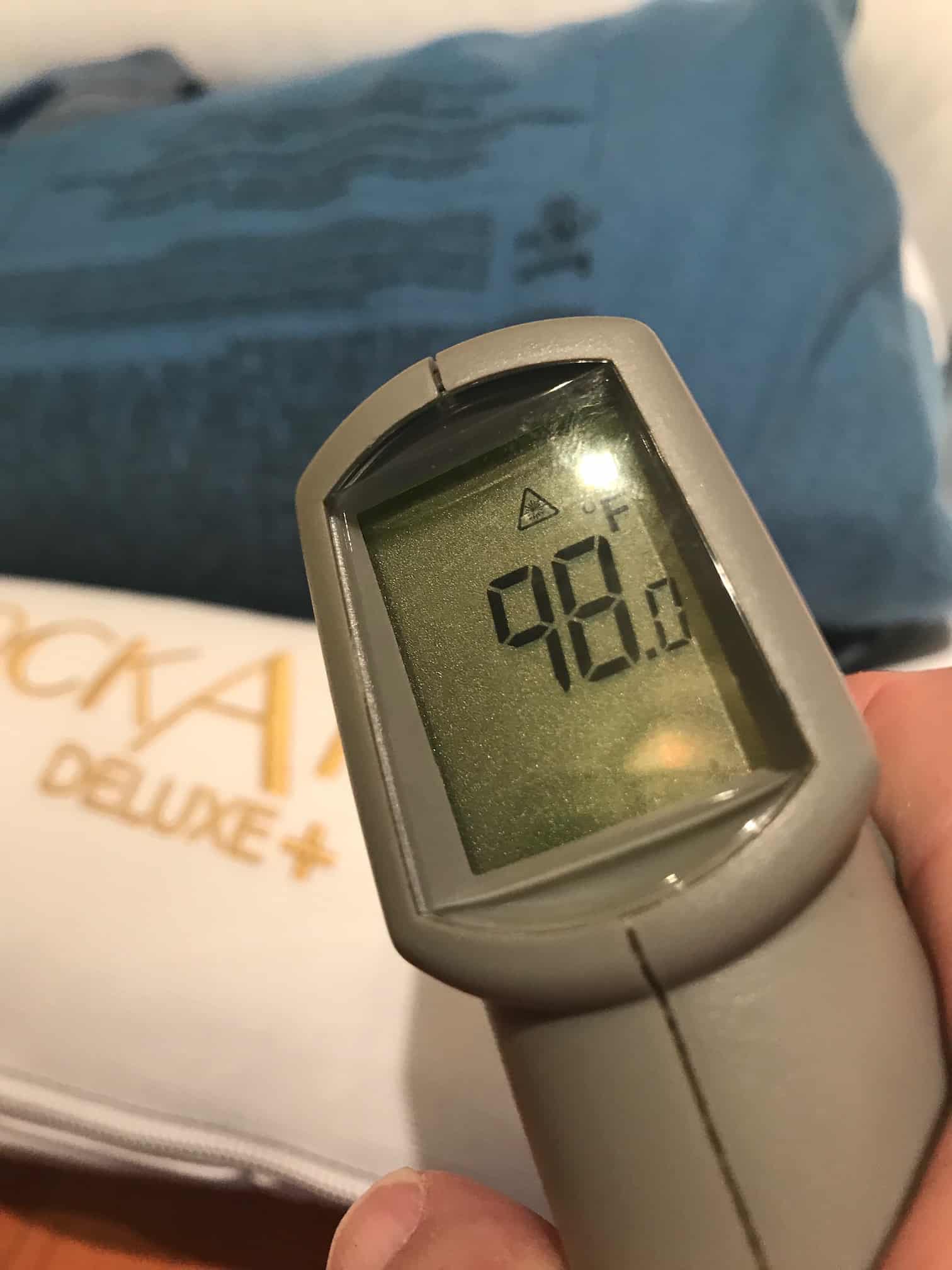
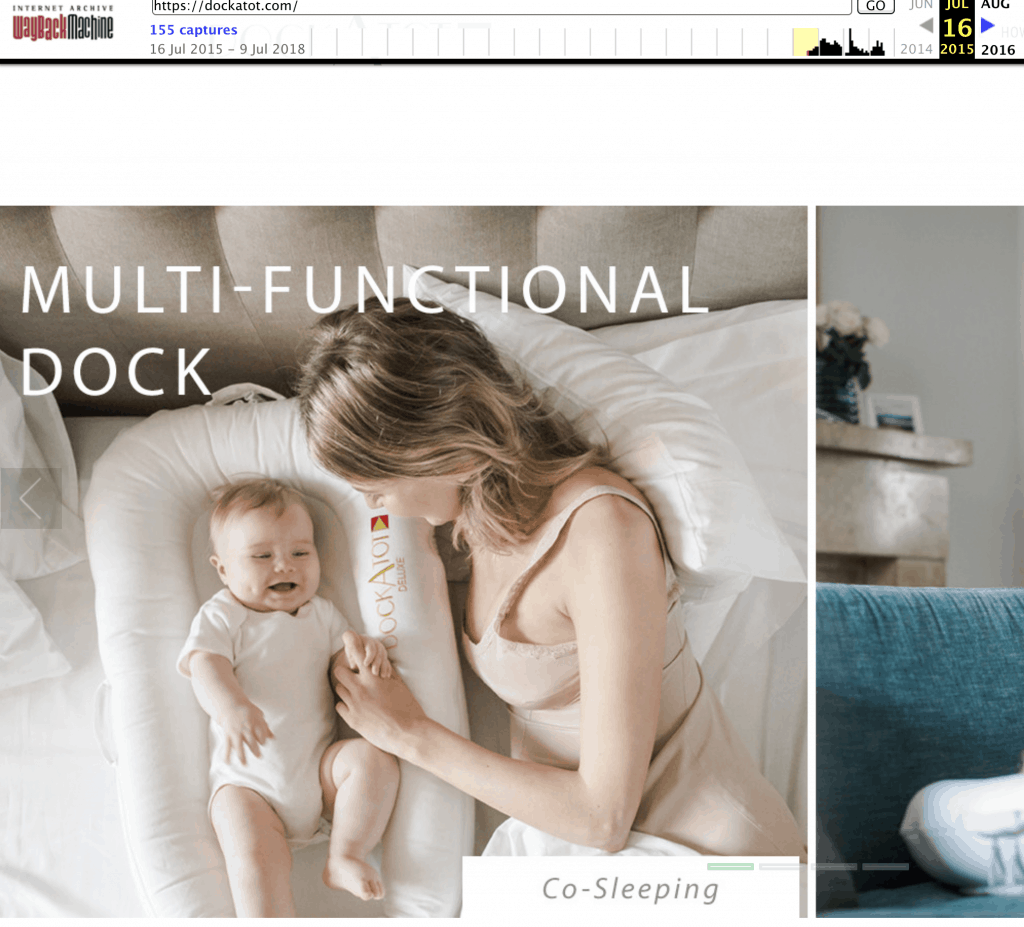
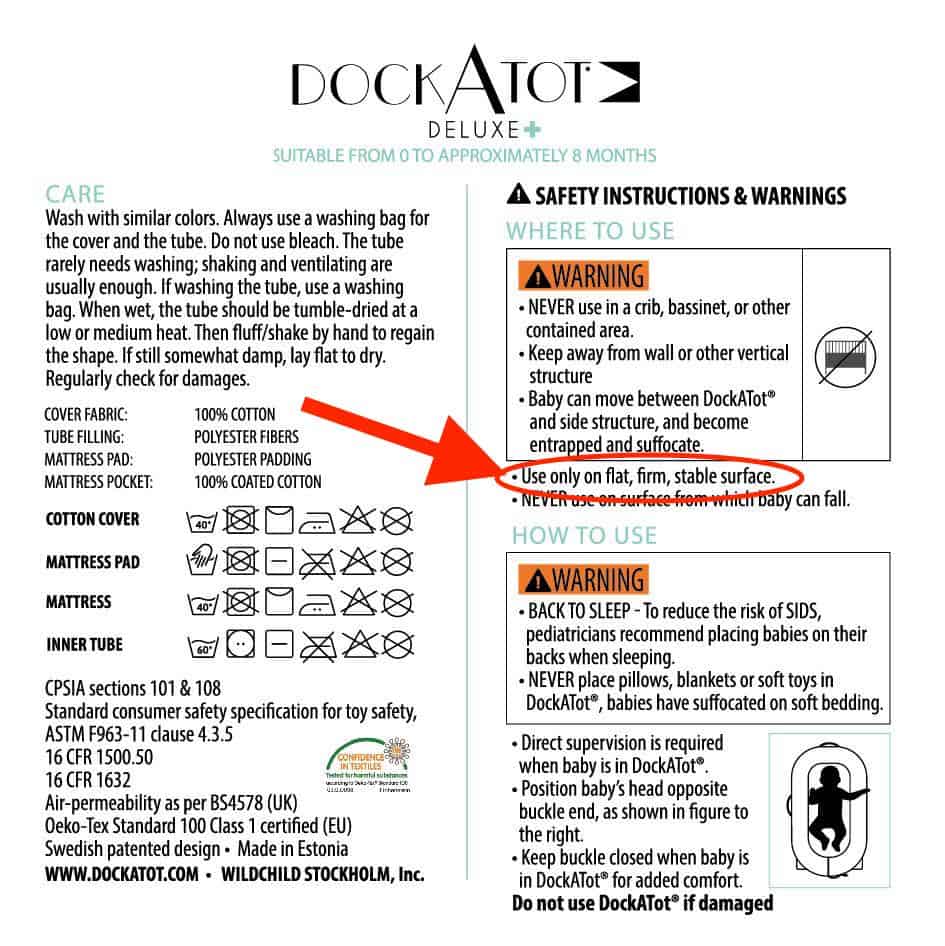

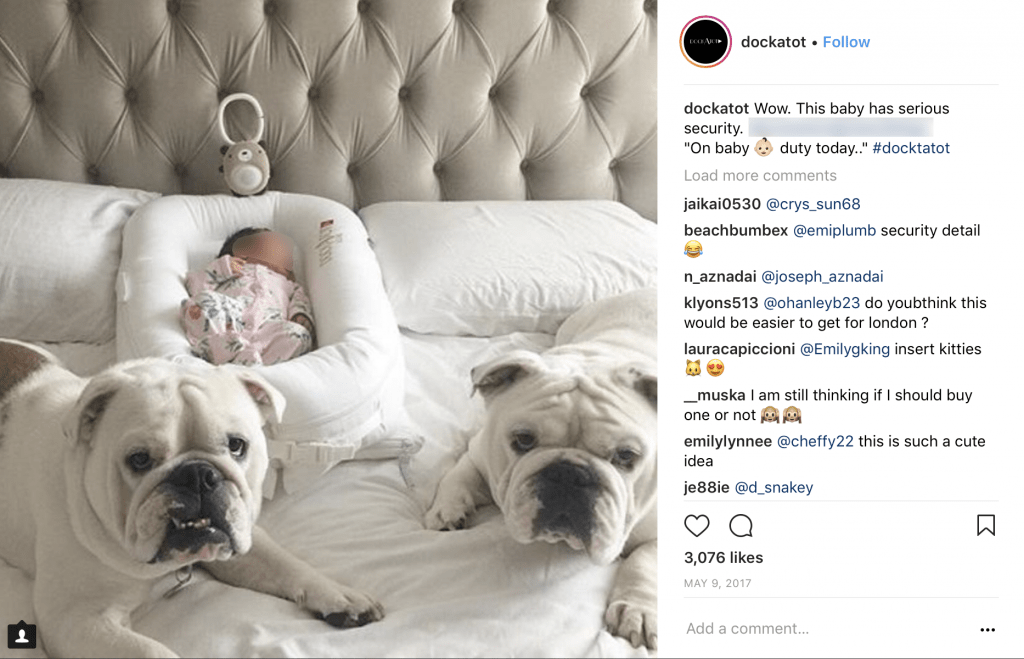
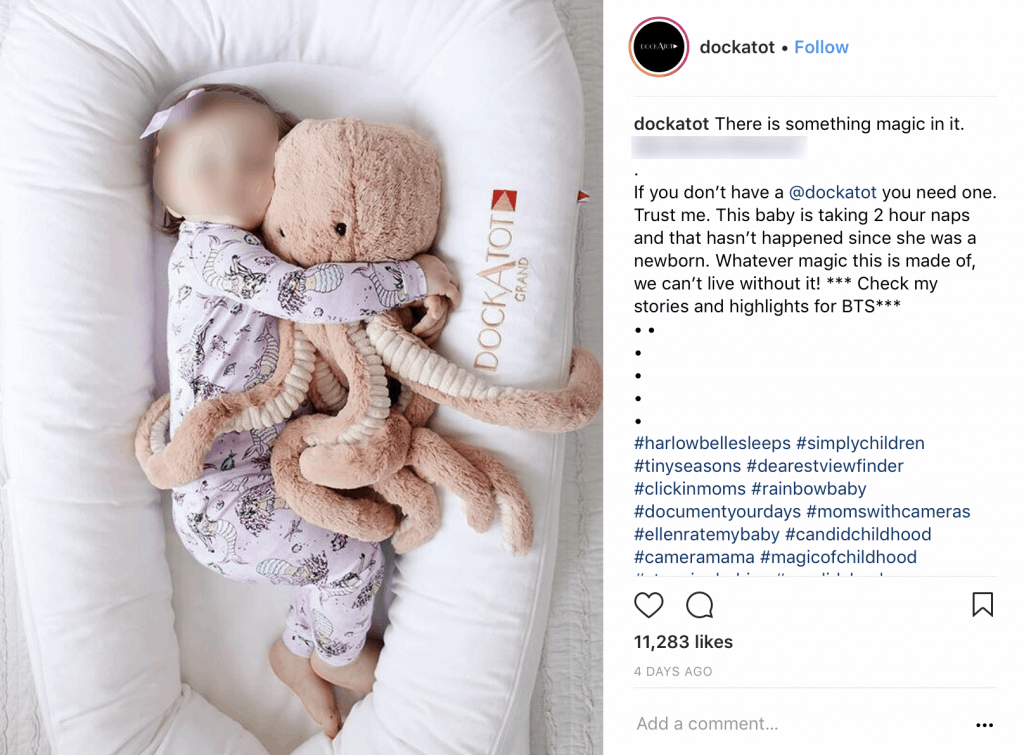
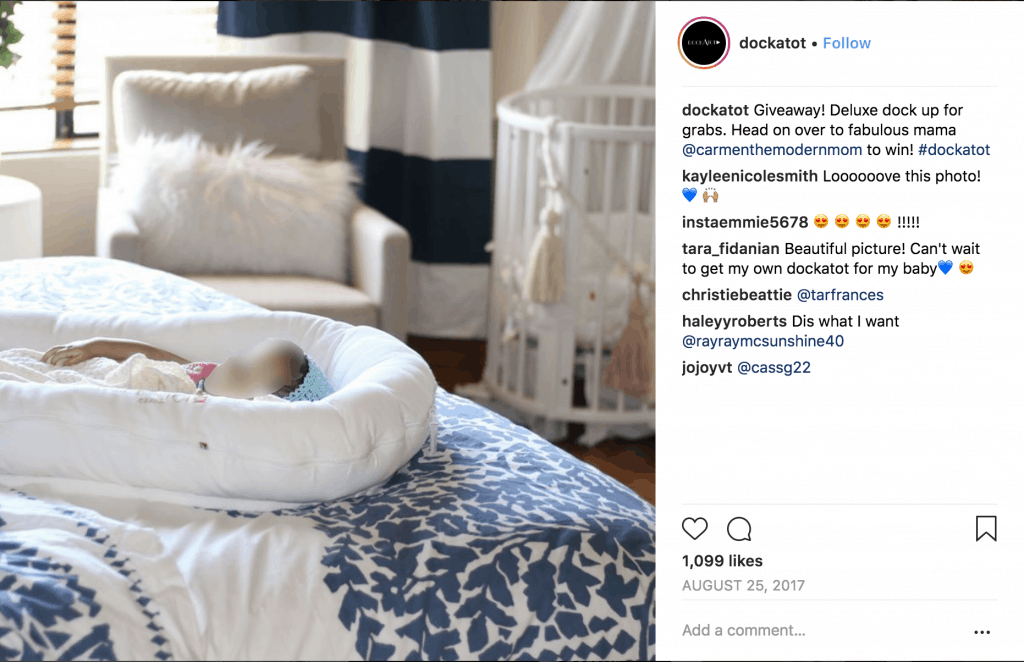
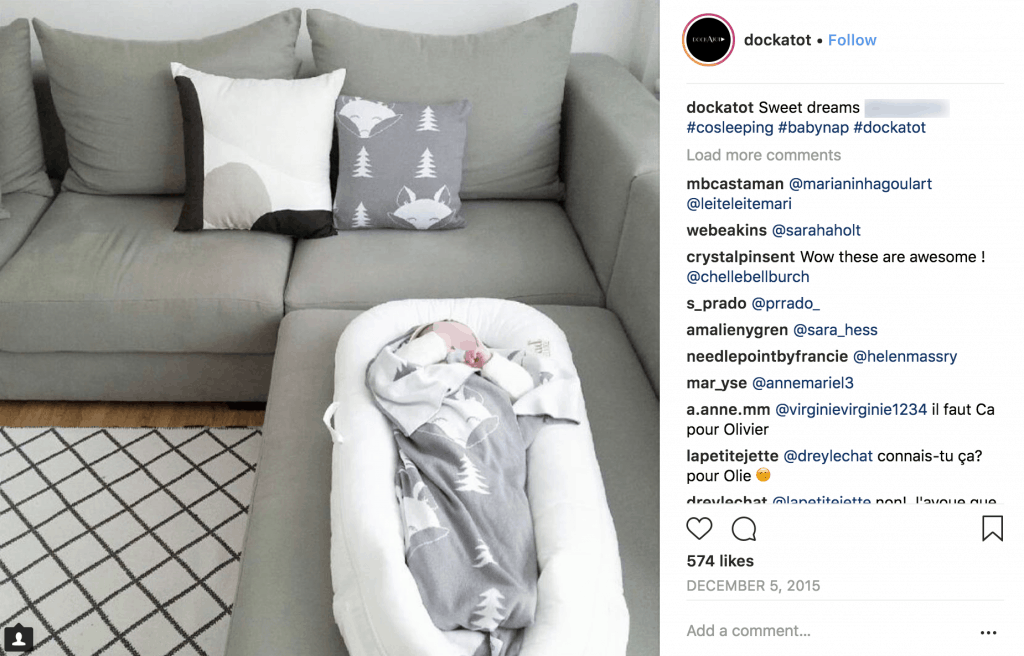
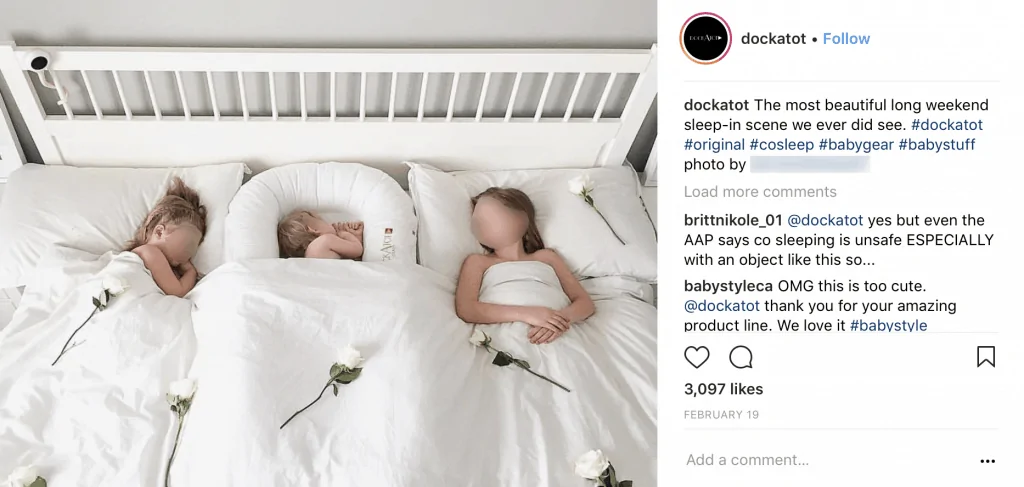
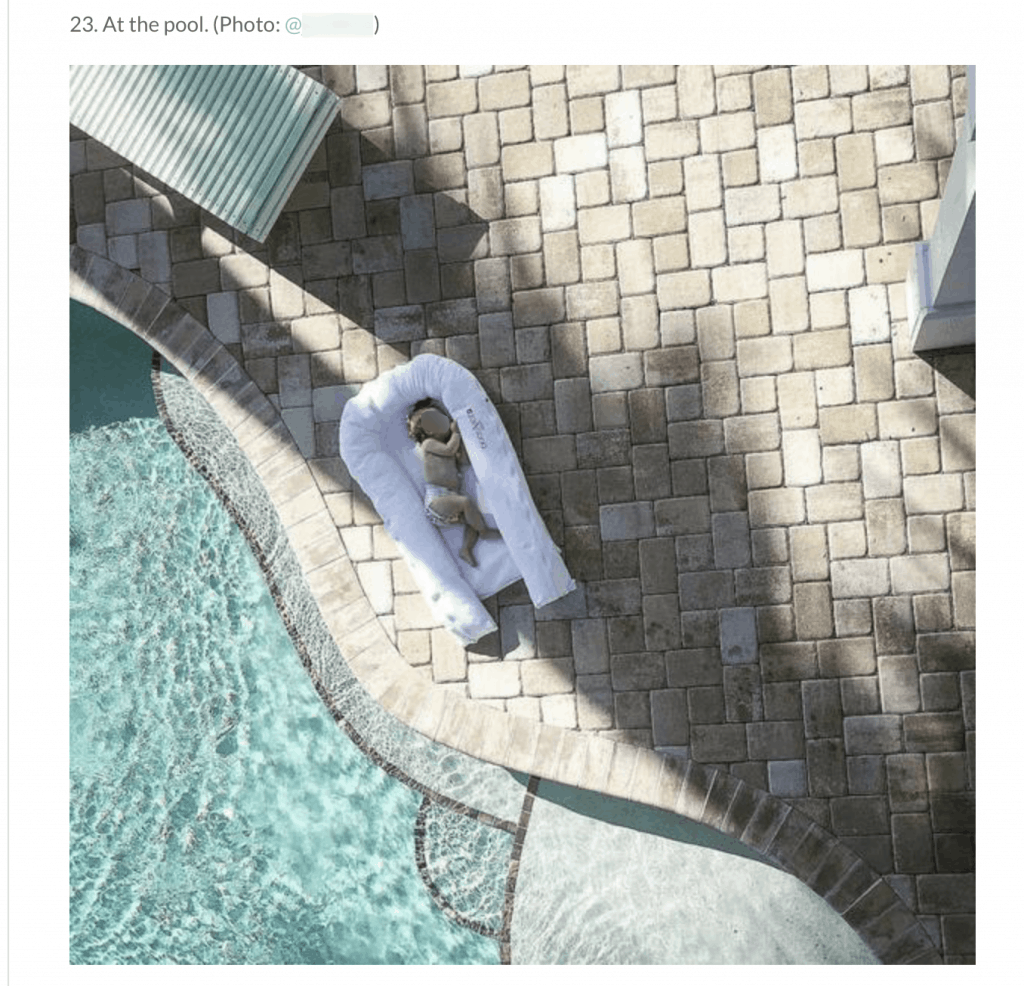

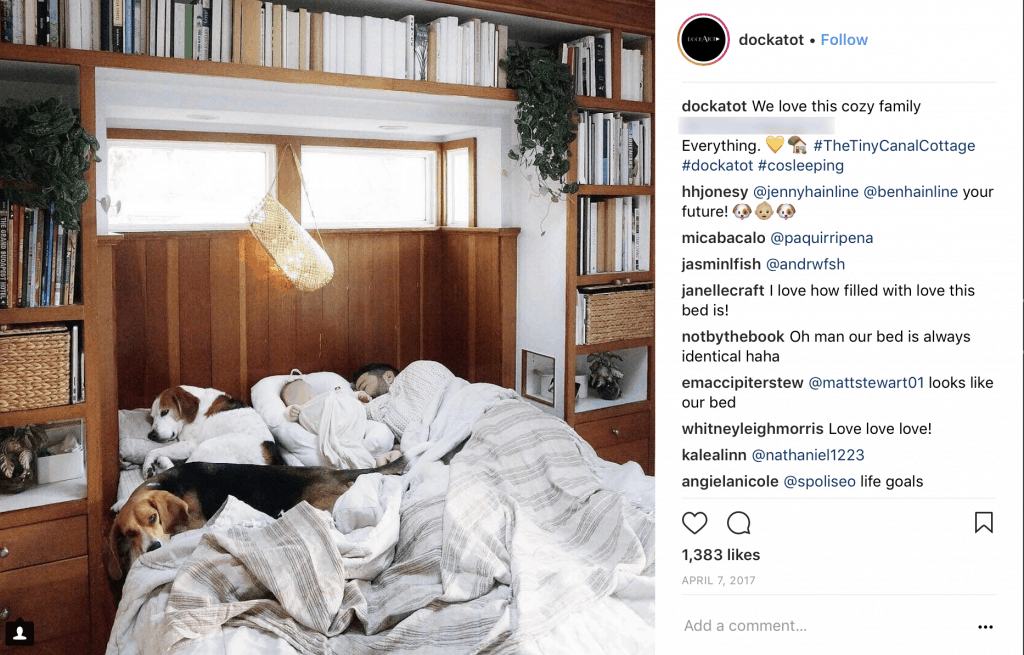
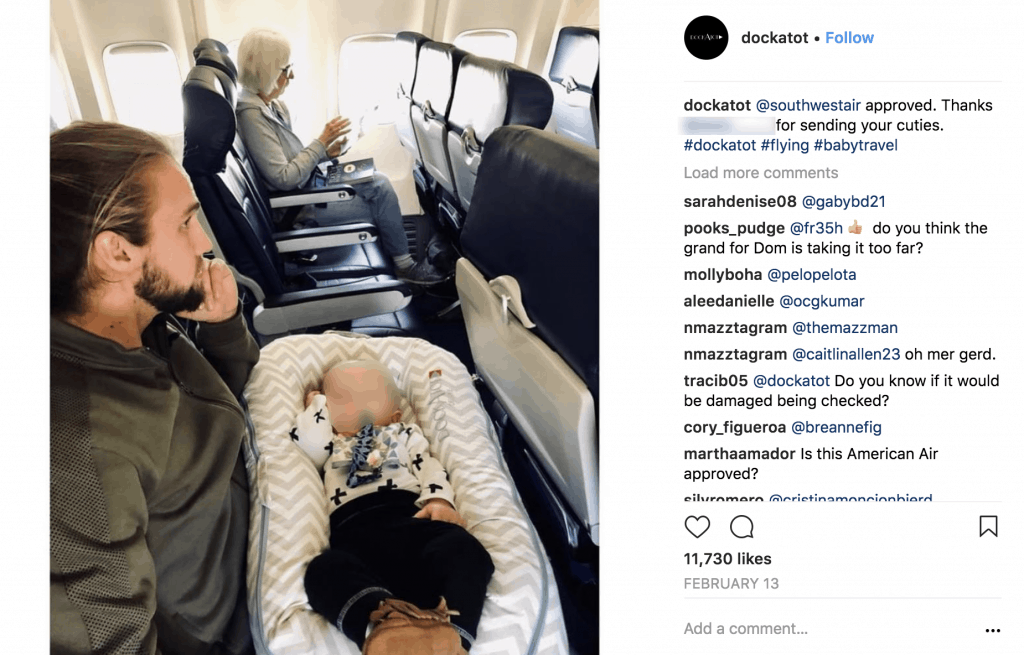
 We obsess over gear for families and the home . . . so you don’t have to. Baby Bargains has one mission: help you find the best gear for your family with unbiased reviews by experts with 20 years of experience. At prices that don’t break the bank. When you purchase a product from links on this site, we make a small affiliate commission. Learn more
We obsess over gear for families and the home . . . so you don’t have to. Baby Bargains has one mission: help you find the best gear for your family with unbiased reviews by experts with 20 years of experience. At prices that don’t break the bank. When you purchase a product from links on this site, we make a small affiliate commission. Learn more 
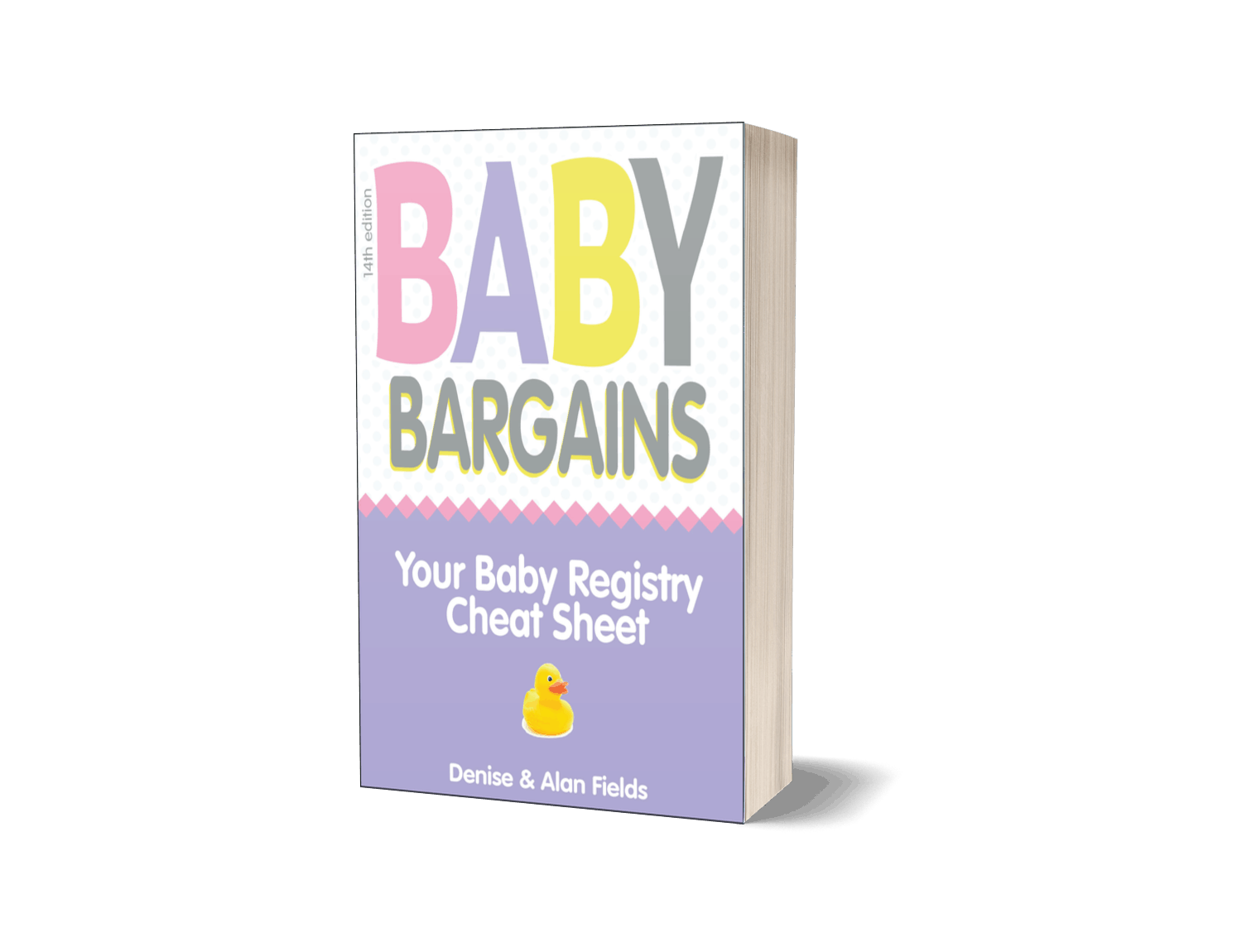
Did you use the DockATot? Or had a friend who did? Please post your experiences here in this comment thread.
Thank you for providing this review of this product. I am the coordinator of a child fatality review team. My team examined the advertising associated with this product and many of the images that owners of the product have posted on the web. In our experience of conducting in-depth reviews of children who have died…….we believe this product should NEVER be used for sleep and a child should not be left unattended in it at anytime.
Have there been any documented cases of a child dying from being in a dockatot??
So what would you recommend for co-sleeping with newborn?
We don’t recommend co-sleeping (in the same bed) with a newborn. We recommend room sharing with a newborn, where the newborn is in a separate sleep space (bassinet or crib). Our bassinet recommendations are here: https://www.babybargains.com/the-best-bassinet/ Thanks for writing in!
Read the book Sweet Sleep by La Leche League
Not even sure why I am replying and what´s the point. But anyway. I love the product. Poor mamas in US. Co-sleeping is s safe as you can feel it. The nature made it possible, babies and mums specialy have the ability to control each other. For safe reasons. Its the nature. Baby need mama close. The babynest Dockatot or any other brands are safe and make you sure the baby is safe if you have doubts your sleep is too deep. My baby loves it, we travel a lot so it is great travel companion for hotels so you do not need a crib. We used it in crib, in adult bed, on couch, floor. As our baby started to roll we took it away, not because we felt it could be danger, but because it was not comfortable for baby anymore. Babies does not have deep sleep, they are still checking their mama, so I believe our baby if she would roll over and her stuck between (Which was imposible for ber) she would wake up, start to cry and let mě know. Mamas should believe in theirselfs, not to be scared like this. This article is written by someone who hates co-sleeping. And even something on this article could be true it´s written just by one side, for me not trustworthy.
We used it a lot for the first 3 months, not for cosleeping but to just to leave the baby as she napped while we were near by. It is really convenient and our daughter seemed to like it.
I have tried several sleep techniques for my daughter. We even splurged on renting a very expensive bassinet with all the bells and whistles. I worried about co-±sleeping and have had a family member die from co-sleeping. I do not advocate it and I believe it is best for the baby to sleep in their own bed.
However, my daughter would not sleep in the bassinet or her crib or anywhere besides with me. I had discussed this with her pediatrician and none of the techniques suggested would help. That being said I set out to make co-sleeping as safe as possible. I placed my mattress on the floor, remove additional bedding and use a dockatot as a barrier. It has worked for my family.
Co-sleeping is a natural state. In the history of humans it is the crib and separation that is new. There needs to be more research into making co-sleeping safe and not just telling parents not to do it. Telling exhausted parents not to co-sleep is like telling amorous teenagers not to have sex. They are probably going to do it anyway so teach them ways to be safe.
Well this is why a generation of Americans are paranoid. If you go house to house in an Asian country, you’d be surprised that most people sleep with their infants until toddlerhood. Don’t even need a dockatot. They just get hard bolster pillows to surround the baby so parents don’t accidentally squish them, if they are the heavy sleeper type light sleepers don’t bother with pillows. We also use firmer mattress than Americans who apparently love sleeping on mattresses that resemble pillows. No wonder your babies smother themselves to death, like literally. This fear mongering is ridiculous. You are, in fact, just telling people not to bed share, when so many people of different cultures have done it through millenia. Accidents happen and bad parents exist, but how in the world is that even the fault of bed sharing or this simply product?? This is why American children are so coddled. You remove everything that can be a potential hazard or threat or cause of an accident. How are they going to go through life if they expect their environment to be a sterile wasteland? Ridiculous.